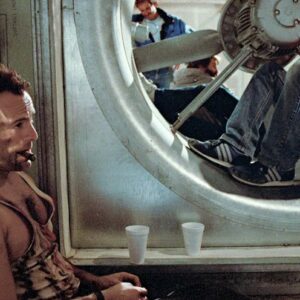Introduction
Bruce Willis, a name that instantly evokes images of high-octane action scenes, wisecracking heroes, and cinematic moments that have become iconic in Hollywood history. With films like Die Hard, Pulp Fiction, and The Fifth Element under his belt, Willis carved out a place for himself as one of the most recognizable and bankable stars of the late 20th and early 21st centuries. However, in 1987, Willis surprised fans and critics alike with a detour into the world of music, releasing his debut album The Return of Bruno. This unexpected move revealed a different side of Willis, one that many were unaware of: the musician. In this in-depth exploration, we will uncover the origins of The Return of Bruno, its reception, the album’s unique sound, and the lasting impact of Bruce Willis’ surprising foray into the music industry.
The Origins of “The Return of Bruno”
To understand the origins of The Return of Bruno, one must first delve into Bruce Willis’ early life and his deep connection to music. Born in 1955 in Idar-Oberstein, West Germany, to an American father and a German mother, Willis was exposed to a variety of cultural influences from a young age. When his family moved to the United States, settling in Penns Grove, New Jersey, Willis found solace and expression in music, particularly blues and soul, genres that would later define his musical output.
Before becoming a global movie star, Willis had a varied career that included working as a bartender in New York City. It was during this time that he honed his musical skills, often performing in small clubs and bars. Willis’ passion for music was more than a passing interest; it was a genuine love that stayed with him even as his acting career began to take off. This passion for music, particularly the blues, is evident throughout The Return of Bruno.
The idea for the album didn’t come out of nowhere. Willis had been toying with the concept of merging his love for music with his growing celebrity status. The opportunity arose in the mid-1980s when he was cast in the popular TV show Moonlighting, where his character, David Addison, often displayed a playful, musical side. The show’s success catapulted Willis to fame, and with it, he gained the confidence to pursue his musical ambitions more seriously.
The album’s title, The Return of Bruno, is a playful reference to a fictional character, Bruno Radolini, whom Willis portrayed in a mockumentary that aired on HBO. The mockumentary humorously chronicled Bruno’s supposed influence on the music industry, painting him as a legendary figure whose contributions were largely forgotten. This tongue-in-cheek approach not only served as a marketing tool but also allowed Willis to explore his musical side without taking himself too seriously. It was a clever way to introduce his music to the world, blending his acting chops with his musical aspirations.
The Sound of the Album
The Return of Bruno is a unique blend of blues, soul, and rock, genres that Willis deeply admired. The album’s production featured notable musicians of the time, including members of The Temptations and Booker T. & the M.G.’s, lending it a sense of authenticity that might have been missing if Willis had attempted to go it alone. The presence of these seasoned musicians helped to elevate the album, giving it a polished yet soulful sound that reflected the spirit of the genres Willis was paying homage to.
The album opens with the track “Comin’ Right Up,” a lively, upbeat song that sets the tone for the rest of the album. Willis’ vocal style, while not traditionally polished, brought a raw, energetic vibe to the music, reflecting his love for the genres he was emulating. His voice carried a certain charm, an everyman quality that resonated with listeners who knew him primarily as an actor.
One of the standout tracks on the album is the lead single, “Respect Yourself,” a cover of the Staple Singers’ hit. Willis’ rendition was upbeat, funky, and showcased his ability to infuse a sense of fun and charisma into his music—traits that fans had come to love in his on-screen roles. The track became a modest success, even reaching the Billboard Hot 100, and was accompanied by a music video that featured Willis in a variety of humorous, over-the-top scenarios, further blurring the line between his musical and acting personas.
Another notable track is “Young Blood,” a cover of the Coasters’ classic. Willis’ version retains the playful energy of the original while adding a bit of his own personality to the mix. The song’s catchy melody and infectious rhythm made it a favorite among listeners, and it remains one of the more memorable tracks on the album.
Throughout The Return of Bruno, Willis explores different musical styles, from the bluesy “Down in Hollywood” to the soulful “Under the Boardwalk,” another cover that showcases his love for classic R&B. Each track is a testament to Willis’ deep appreciation for the music he grew up with, and while his vocal abilities may not have been on par with the legends he was emulating, his passion and enthusiasm were undeniable.
Reception and Legacy
Upon its release, The Return of Bruno received mixed reviews from critics. Some appreciated Willis’ enthusiasm and genuine love for music, while others viewed the album as a vanity project, a celebrity indulging in a side project simply because he could. The polarized reception was perhaps inevitable; after all, it’s not every day that a major Hollywood star releases a blues and soul album.
Despite the critical divide, The Return of Bruno found a place in pop culture, largely due to Willis’ star power. The album’s success was bolstered by the accompanying HBO mockumentary, which added a layer of humor and satire to the project. Fans of Willis appreciated the album for what it was: a fun, nostalgic trip through the music of the past, led by an actor who wasn’t afraid to take risks and step outside his comfort zone.
The album’s legacy is an interesting one. While it never achieved the musical acclaim of albums by professional musicians, The Return of Bruno remains a unique artifact of the 1980s. It symbolizes the era’s fascination with celebrity crossover projects and stands as a testament to Willis’ willingness to pursue his passions outside of acting. The album also paved the way for other actors to explore their musical ambitions, contributing to the trend of celebrity musicianship that continues to this day.
In the years following the release of The Return of Bruno, Willis would go on to release two more albums: If It Don’t Kill You, It Just Makes You Stronger in 1989 and Classic Bruce Willis: The Universal Masters Collection in 2001, a compilation album that featured tracks from his previous releases. While neither of these albums achieved the same level of attention as his debut, they reinforced Willis’ commitment to his musical endeavors and demonstrated that his love for music was more than just a passing phase.
The Cultural Impact of “The Return of Bruno”
The Return of Bruno occupies a unique space in the cultural landscape of the 1980s. The album, along with its accompanying mockumentary, was emblematic of a time when celebrities were increasingly exploring avenues outside of their primary careers. The 1980s saw a surge in celebrity crossover projects, from Eddie Murphy’s foray into music with Party All the Time to Don Johnson’s album Heartbeat. Willis’ The Return of Bruno fits neatly into this trend, serving as a quintessential example of the era’s fascination with celebrity experimentation.
One of the most significant cultural impacts of The Return of Bruno is its role in shaping the public’s perception of Bruce Willis. Before the album’s release, Willis was primarily known as a television actor, thanks to his role in Moonlighting. However, The Return of Bruno showcased a different side of Willis, one that was more playful, musically inclined, and willing to take risks. This willingness to step outside of his established persona endeared Willis to fans and helped solidify his image as a multi-talented entertainer.
The album also had an impact on the music industry, albeit in a more subtle way. By collaborating with established musicians and paying homage to classic blues and soul tracks, Willis demonstrated a respect for the music that transcended mere celebrity vanity. His involvement in the project helped to bring attention to the genres he loved, introducing them to a new generation of listeners who may not have been familiar with the original artists.
In a broader sense, The Return of Bruno can be seen as part of the larger trend of celebrity musicianship that has continued to evolve over the decades. In the years since the album’s release, countless actors, athletes, and other celebrities have tried their hand at music, with varying degrees of success. While not all of these endeavors have been as well-received as Willis’, The Return of Bruno set a precedent for celebrities exploring their musical passions and finding a place for themselves in the industry.
Bruce Willis: Actor, Musician, Risk-Taker
The Return of Bruno is more than just a debut album; it’s a snapshot of a moment when Bruce Willis was willing to step out of his comfort zone and share a different side of himself with the world. For those who knew him as an action star, the album was a revelation, showing that Willis was more than just a one-dimensional Hollywood actor. It revealed a man who was unafraid to take risks, to explore new creative avenues, and to share his love of music with his fans.
In many ways, The Return of Bruno is a testament to Willis’ versatility as an entertainer. While his acting career would continue to dominate his professional life, the album showed that he was not content to be pigeonholed into a single role. Willis’ willingness to take on new challenges, whether in music or film, is a defining characteristic of his career and one that has endeared him to audiences around the world.
The album also highlights an important aspect of Willis’ personality: his sense of humor. The HBO mockumentary that accompanied The Return of Bruno is a perfect example of this, as it poked fun at the idea of a Hollywood star trying to make it in the music industry. By not taking himself too seriously, Willis was able to navigate the potential pitfalls of such a project and turn it into a success on his own terms.
Even though The Return of Bruno may not have changed the music industry, it did something equally important—it allowed Bruce Willis to explore his creative boundaries and connect with audiences in a new and unexpected way. The album stands as a reminder that even the most successful and established artists are capable of surprising us when they follow their passions.
The Lasting Influence of “The Return of Bruno”
In the years since its release, The Return of Bruno has maintained a certain cult status among fans of Bruce Willis and 1980s pop culture. While it may not be as widely remembered as his iconic film roles, the album has a devoted following that appreciates it for what it is: a fun, nostalgic trip through the music of the past, led by one of Hollywood’s biggest stars.
The album’s influence can also be seen in the continued trend of celebrity musicianship. In the decades since The Return of Bruno, countless actors and other celebrities have followed in Willis’ footsteps, releasing albums that showcase their musical talents. Some, like Jared Leto with his band Thirty Seconds to Mars, have gone on to achieve significant success in the music industry, while others have found their musical endeavors to be more of a personal passion project.
For Willis himself, The Return of Bruno remains a unique chapter in his career, one that he looks back on with fondness. In interviews, Willis has spoken about his love for music and the joy he felt in being able to share that passion with the world. While he may not have pursued a full-time career in music, the album remains a testament to his willingness to take risks and follow his creative instincts.
Conclusion
Bruce Willis’ The Return of Bruno might not be the first thing that comes to mind when you think of his career, but it remains a fascinating chapter in the life of an actor who dared to dream beyond the silver screen. The album, with its blend of blues, soul, and rock, is a reflection of Willis’ deep love for music and his willingness to explore new creative avenues. Whether you’re a die-hard Willis fan or just curious about this unique project, The Return of Bruno is worth revisiting for its quirky charm and its place in pop culture history.
In the end, The Return of Bruno is more than just an album—it’s a statement. It’s a statement about the power of passion, the importance of following your dreams, and the value of taking risks, even when the odds are against you. Bruce Willis may be best known as an action star, but with The Return of Bruno, he showed the world that he was much more than that. He was an artist, a musician, and, above all, a risk-taker.
Call to Action
What do you think of Bruce Willis’ musical endeavor? Have you listened to The Return of Bruno? Share your thoughts in the comments below! Whether you’re a fan of his music or simply intrigued by the idea of a Hollywood star releasing a blues album, The Return of Bruno is a piece of pop culture history that deserves to be explored and appreciated. So, dust off that old vinyl or find the album on your favorite streaming service, and take a journey back to 1987, when Bruce Willis proved that he was more than just an action hero—he was a musician with a passion for the blues.





